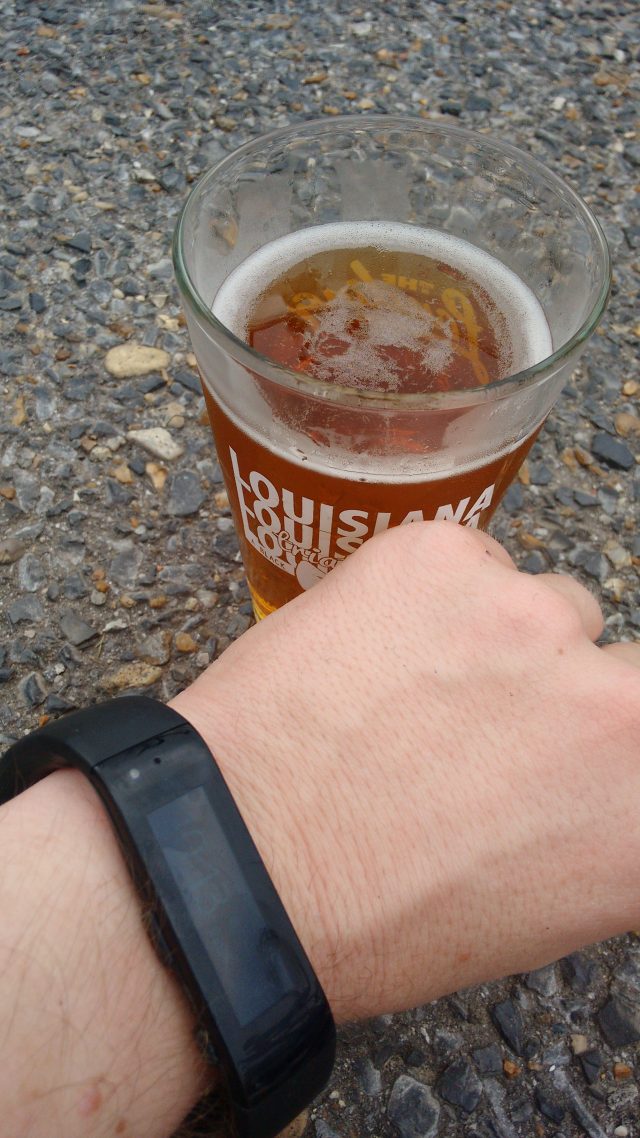
Last weekend, I ran a 5K in about a half hour. After four months of training, I'll be the first to admit that's decidedly average.
There's a catch of course. This run followed 18+ miles of cycling and a half-mile open water swim at the 2015 Louisiana Triathlon. It's not an every-finisher-gets-a-medal race, but the pint glass pictured felt like prize and proof enough. Yet if you ask the fitness tracker I used during and leading up to the event—the Microsoft Band—I simply went on a really, really long bike ride, one that never ended because some racer's sweaty fingers couldn't properly interact with a small touch interface.In an instant, this describes the shortcomings of the Microsoft Band. It can help a beginner (or someone close to it) improve their fitness to competitive levels, but it can't take a competitor (even a low-level one) to new heights. And that assessment doesn't even factor in the device's shortcomings outside the Microsoft ecosystem or in the context of the burgeoning wearables market.
Setup in three easy steps months
We purchased a test Band in fall 2014. Before ever attempting to use it with iOS, I expected trouble. Disappointed users littered the App Store comments for Microsoft Health, the accompanying app needed for Band administration. "The device does not sync properly," read the top review slot at the time. "It was far too difficult and time consuming to get the Band to pair (and then stay paired) to my iPhone 6," read another. "The process ought to be simple and straight forward, but it was fraught with needless frustration." Even today with the band upgraded from version 1.3.1017 to 1.3.10427 in the last six months, five of the top 10 App Store reviews complain about this syncing and pairing connectivity.
However, these are just users. Surely some tech journalist—one who's not too proud as to skip official directions at that—could avoid the same fate. Right?
Our first continuous attempts to setup a test Band simultaneously involved an iPad 2 and an iPhone 4S, both running iOS 8.1. According to Microsoft's official system requirements, the band should explicitly work with the latter device while the iPad was admittedly an experiment. (Late last month, WinBeta spotted the Microsoft Store listing for the Health app finally noting iPad compatibility, but no app version for the iPad could be downloaded at the time.) Over the course of those few months with at least bi-weekly attempts, the Band never played nicely with the iOS devices.
There was no shortage of effort, however. I tried simple setup troubleshooting like disconnecting and reconnecting the devices over Bluetooth several times and also uninstalling/reinstalling the Health app. Factory reset requires navigating the Band's interface, which requires a setup Band—not an option. At times, both the Band and iOS Settings would indicate a successful pairing, but opening the app would lead to either an error message telling me to check Bluetooth settings or to a “Finish pairing" screen. Unfortunately, that message never resolved and instead kicked me back to the initial five-step setup screen.
-
Oh sweet, seems like things worked out...
-
PSYCHE! Still not connected.
-
Why are you lying to me, Band?
-
-
So close to success on the iPhone...
-
...but step five never seemed to lead anywhere on iPad or iPhone.
Ars Microsoft Editor Peter Bright previously paired the device with a Windows Phone, so in conversations with Band support teams this became a possible reason for the error. To utilize a Band with another device—within the same operating system or not—the initial Band-phone pairing must be un-paired before a new phone can successfully connect. Un-pairing turns out to be its own multistep process: a user must unregister the Band within the corresponding Microsoft Health app, forget the Band entirely within the phone's Bluetooth settings, and then (if possible) perform a factory reset through the Band's UI. Once starting from "scratch" (i.e. not paired with the new or old phone's settings or mobile app), then it's possible to sync a Band with the second device. (Peter did all that before sending our test unit my way, happy to let me wade in the iOS/training waters.)
I never did successfully link up our test band with the iPad 2 or iPhone 4S, nor did I successfully link up a Microsoft-provided "fresh" band with either device. Instead, the ultimate fix came from Santa Claus. An iPhone 6 became available for testing after the winter holidays, and that connected with the now personalized "Steely Band" in January 2015. Even then, the process took a few attempts, but once synced I no longer needed to deal with the same pairing woes again and again. (The successful pairing happened through the same process as unsuccessful ones, all outlined in Microsoft's Band setup guide. I experienced the same scenario—a few hiccups, ultimately an OK pairing—when later syncing the same test Band to a second-gen Moto G running Android 5.0.2.)
-
Sweet, sweet confirmation.
-
Uh, even successful pairings involved a few headscratching moments.
reader comments
60